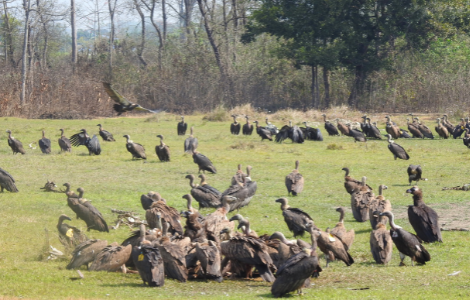
VULTURE CONSERVATION PROGRAM
Vultures play a highly important ecological role through the rapid consumption of animal carcasses. They also have an important cultural role in the consumption of human dead bodies in sky burials within Nepal and Tibet.
Out of nine species of vultures, five species of vultures in Asia are in grave danger of extinction across the Indian subcontinent. Populations of White-rumped Gyps bengalensis, Long-billed G. indicus and Slender-billed Vultures G. tenuirostris have declined by more than 99% in India (Prakash et al. 2003; Pain et al. 2004) and Pakistan and annual rates of decline appear to be increasing. Further two more species of vultures, Red-headed Vulture and Egyptian Vulture have rapidly declined in the recent years (Cuthbert et al. 2006). Due to these declines, all five species are now listed threatened by IUCN - The International Union for Conservation of Nature. Except Egyptian Vulture which is listed as Endangered all other four are listed as Critically Endangered which is the highest threat category. In Nepal White-rumped Vultures have been declined over 91% till 2003 (Baral et al. 2004) and declined by 91% till 2011 (Chaudhary et al. 2011).
The cause of these declines has been shown to be the veterinary drug diclofenac (Oaks et al. 2004, Swarup et al. 2007), which is widely used to treat livestock in Asia. Vultures are exposed to diclofenac by feeding on livestock carcasses which contain residues of this drug. A post-mortem examination of dead or dying birds from India and Nepal showed a high incidence of diclofenac residues and visceral gout (Shultz et al. 2004). The result of mathematical modeling is consistent with the observed rate of population decline. Models indicate that only a small proportion (1 in 130) of carcasses contaminated with lethal levels of diclofenac can cause the observed vulture mortality rate (Green et al. 2004).
In order to halt the decline of these critically endangered birds, Government of Nepal put ban on production, import and use of veterinary diclofenac in June 2006 and endorsed Vulture Conservation Action Plan for Nepal (2009-13) in 2009. Vulture Conservation Action Plan for Nepal (2009-2013) is a part of the greater effort of the Government of Nepal to conserve and consolidate the conservation initiatives for all vulture species found in Nepal. The main objective of Vulture Conservation Action Plan is to prevent the extinction of vulture species by ensuring re-introduction, safe food supply, maintenance of suitable habitat and better understanding of the ecological importance of these birds in Nepal with a goal to revive viable population of vultures in the wild. Vulture Conservation and Breeding Centre was established on 2008 in partnership of Department of National Park and Wildlife Conservation (DNPWC), National Trust for Nature Conservation (NTNC) and Bird Conservation Nepal (BCN).
Bird Conservation Nepal has been supporting this Vulture Conservation Action Plan through integrated approach to conserve vultures in Nepal which involves scientific research, advocacy, sensitization, monitoring the use of NSAIDs, the collection of veterinarian pledges to stop using diclofenac and the operation of six vulture safe feeding sites. Within this line BCN has initiated projects under Vulture Conservation Programme. Under these projects a range of conservation action including in-situ and ex-situ measures has been implemented to support Vulture Conservation Programme.
Vulture Conservation Programme
- Scientific Research and Monitoring
- Advocacy, Awareness and capacity buildings
- Vulture Safe Zones and Community managed Vulture Safe Feeding Sites
- Vulture Conservation Breeding Centre
- Enhancing Community-Based Vulture Conservation in Western Lowland of Nepal
- In-situ conservation of Critically Endangered White-rumped Vulture (Gyps bengalensis) in Dang district, Nepal
- Red-headed Vulture Project
- Protecting the critically endangered vultures of Suklaphanta Wildlife Reserve and Kailali District, Nepal through community-based integrated approaches.
- Strengthening the Local Communities for In-Situ Conservation of Critically Endangered Vultures in Western Mid-Hills of Nepal.
- Integrating vulture safe zones with wider landscape-level conservation to save Critically Endangered vultures in Nepal.
- Initial Release Phase of the Nepal Vulture Recovery Program using a telemetry study of White-rumped Vultures to measure the prevalence of diclofenac in wild vulture food and to test the assimilation of captive vultures into the wild.